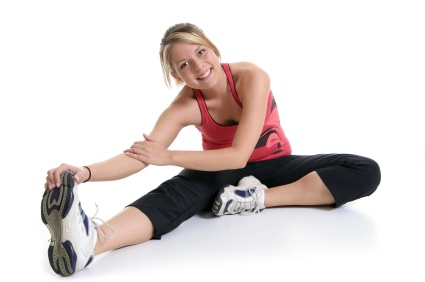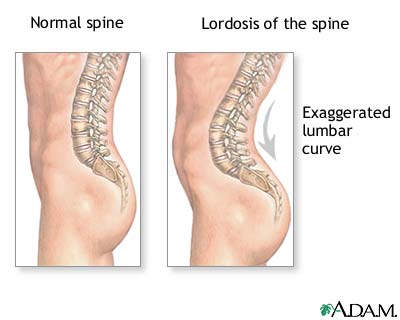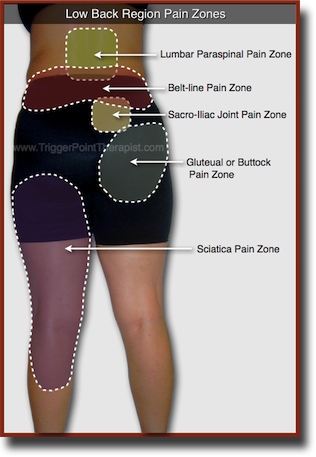Happy Thanksgiving! Well, a few days late, anyway. I hope you all have a wonderful holiday with your family and friends, and hopefully you get to try out--making or tasting--some awesome new recipes!
Last time I talked about upper back/neck and the postural deviations that typically go along with it. Today I want to address lower back and hip/glute issues. A lot of people who mention that they are experiencing low back pain generally point to the lower back into the upper gluteal region. They'll say that their job is a 9-5 computer work job, and they sit at a desk all day--potentially also requiring them a lot of drive time commute.

Now something that happens when you sit in this position all day long is weakening of the glutes--your butt muscles. The three butt muscles are gluteus maximus, gluteus medius and gluteus minimus. Basically, you're sitting with your glutes in a stretched position for a long period of time--with the weight of your body enhancing that stretch, so to say. Typically associated with that is tight hip flexor muscles- the muscles that help bring your knees closer to your body at the front crease of your hip. Moving and stretching this overworked (over flexed) area is important if you want to avoid hip spasms or tight quads.
Glute weakness and back pain are very closely related. And if you have any sort of postural imbalance, such as a hyper lordosis, in that low back area, it could add to the discomfort. Remember kyphosis, the rounding of the shoulders and upper back that we mentioned last post? Hyper lordosis is kind of similar, but in the low back--also an outward curvature that shouldn't be quite that pronounced for good postural health. Check it out:
The picture above is of kyphosis in the upper back (left) and a hyper lordosis in the low back (right).
Some curvature in the low back is totally natural. Same goes for the upper back, a little curve in the spine is normal. When either of these are more pronounced than usual, it typically leads to some muscular discomfort. With hyper lordosis, there is just too much pressure on those lumbar vertebrae- especially when sitting for long periods of time. In the case of kyphosis in the upper back, you'll feel as if your shoulders are always tight and you'll feel the discomfort between the shoulder blades. Sound familiar? I call it, "Silicon Valley Syndrome."
Common areas cited for low back pain.
Trigger points are little nodules (aka knots) of hyper tension in a muscle that can be locally sensitive to the touch. They can also exist without any pain until they are worked on, and they can also refer pain from one area of the body to another area. This is a common occurrence with low back pain and gluteal tightness. Often times, when people have "sciatic nerve pain" or "sciatica", they are just saying that because that is what they think it is. Pain in the back of the leg, through the glute and all over your hamstring and adductors? It
sounds like sciatica, right? Perhaps. It is also possible that it is a trigger point referral pattern, and not actual sciatica, and it is referring pain from one area down through the posterior leg. Hooray! In that situation, it is better to have it be a mere trigger point that can be worked out!
Typically, unless there is a previous accident or major injury to take into account, it is a muscular imbalance. Not to fear, 99.9999% of people have at least one--and no, that is not an actual statistic. It IS incredibly common, however. Every muscle as an opposing "buddy" in movement. For example, your glutes primarily swing your leg backward and stabilize movement when walking, while the adductors in your thighs help swing your leg forward. The muscle is in "work mode" when the muscle fibers are being shortened, or flexed. If the glutes are weakened via inactivity, it will affect how your adductors respond when being called upon to do their task, and can result in tightness and inner thigh pain, even up into the groin.
So what the heck do you do? If your weak in the hips and gluteal muscles, clearly we need to strengthen those areas. Although, if it is super tight and restricted, they need to be stretched. Many, including yours truly, have a combo of both. Because my gluteals are not as strong as they should be, other muscles in my body- namely my adductors, calves and low back- have to do a LOT more work than needed to help stabilize and compensate for my weakness. The body also goes into protective mode saying, "Hey! Those glutes can't do that, so let's create a barrier so it doesn't hurt anything else!" Usually, this means the development of that low back belt of tightness and restriction of "harmful movement" in the surrounding areas. It is a protective mechanism, but it limits proper function, which can lead to more imbalances. BAH!
So step # 1- Get some of that tight restriction out of the way. Stretch frequently and get massage done to help loosen some of those locked up areas. Below are some great stretches for loosening up the hips, glutes and hip flexors:
Hip flexor stretch: enhanced lunges
This is a simple yet effective low back/glute stretch to do while at the office!
Stretching the hip and gluteus medius with "secretaries"
The wall stretch: effective and EASY! Gravity does most of the work for you!
Step #2- Strengthen those weakened muscles! You CAN strengthen while stretching, but I wouldn't make it the primary goal on a super restricted person. If you have tight pecs, I won't tell you to do 100 push ups or bench presses a day, because you're strengthening an already shortened muscle group. Just go easy, and be sure to stretch before and after activity.
Modified bridges on a stability ball
3 exercises demonstrated, but I really like the "peeing dog/fire hydrant" one a lot!
This is a little more challenging, but really awesome at targeting glute medius/minimus and also aids in core strength
Step #3- Maintain good posture and home care practices. This is certainly easier said than done, but will be vital to overall success and long lasting results. Consider investing in a foam roller to work out some of that low back and glute tightness. Foam rollers are foam cylinders that come in different sizes and density, and they're designed to facilitate myofascial release of scar tissue and trigger points on your own terms. I just had the pleasure (and pain!) of trying out two different foam rollers at REI last night--The Grid and the Y Roller. Oh man....beastly! These are hardcore foam rollers that WILL break up adhesions and WILL last you a long time! Foam rolling is a great thing to do to maintain the results of a massage, and as a warm up pre-event for sports or physical activity. You can get these online through retailers like Amazon or in stores like REI and Sports Authority. The Grid and other fancy textured rollers are a bit pricy, but a great self-care tool to invest in. The standard roller you can find at Target, TJ Maxx and Marshalls for a lot less! The thing I like about The Grid is the PVC core. Other rollers are foam with varying density, but it might lose firmness after a while. You won't have that problem with The Grid or Y Roller. There are plenty out there, these are just the ones I have tried. The important thing is to take your time while rolling. Slow down and breathe, especially when you find a tight spot.

The Grid. (above)
The Y Roller.
Here is an example of how you can foam roll your hips and glutes!
And as always, staying properly hydrated is good for you in a number of ways, including muscle malleability. You are able to receive massage--especially the deeper work--better when properly hydrated. My strange abstract mind: Think of your body like a big piece of steak or something. Beef jerky isn't very tender, and you'd really have to hammer it out if you want it to tenderize somehow, but it wouldn't be easy (or comfortable!) If you were nicely marinated, like a filet mignon, you could tenderize the heck out of that baby! Channel your inner $22 steak. Drink your water! :P
So this was a long one, all. I hope you found it useful and informative, and I hope you can start utilizing some of these methods to get more strength and flexibility in that low back/gluteal region. Have a fabulous day, and I'll see you on the table soon!
my image sources and additional information sources:
www.triggerpointtherapist.com
www.theofficeeffect.com
www.riversideonline.com
http://rpm-therapy.com/massage-blog
 First of all, hello everyone! I have been terribly behind on posting, but basically my wedding took over my life. Plain and simple. I'm married and now I'm finally ready to blog again! I have so much I want to post, but I have must come back on a slightly heavy note.
First of all, hello everyone! I have been terribly behind on posting, but basically my wedding took over my life. Plain and simple. I'm married and now I'm finally ready to blog again! I have so much I want to post, but I have must come back on a slightly heavy note. 









